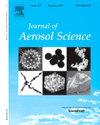Optimizing computation time in 3D air quality models by using aerosol superbins within a sectional size distribution approach: Application to the CHIMERE model
IF 3.9
3区 环境科学与生态学
Q2 ENGINEERING, CHEMICAL
引用次数: 0
Abstract
One limitation of the operational application of air-quality models at high resolution for forecasting or for the evaluation of emission mitigation scenario is the computational cost. It may also be an important limitation to the use of more complex (but more realistic) secondary organic aerosol (SOA) schemes. While the size distribution may be accurately described with a sectional approach to resolve processes involved in aerosol dynamics, it also leads to large CPU time due to the number of size bins that need to be used.
In this study, we developed a “superbin” approach consisting in lumping for a given species several size bins into a single size superbin and to use a specified size distribution to distribute the superbin concentration into the different bins of CHIMERE when needed.
Together with the revision of the numerical resolution algorithm, the ”superbin” approach was implemented into a new version of CHIMERE (based on v2020r1) in order to optimize the CPU time performance. The computation time was reduced by 60% with induced errors on PM10 concentrations around 3% to 7% over most of Europe. The use of the “superbin” approach proved to be much more efficient in terms of computational time and errors compared to simply reducing the number of bins.

求助全文
约1分钟内获得全文
求助全文
来源期刊

Journal of Aerosol Science
环境科学-工程:化工
CiteScore
8.80
自引率
8.90%
发文量
127
审稿时长
35 days
期刊介绍:
Founded in 1970, the Journal of Aerosol Science considers itself the prime vehicle for the publication of original work as well as reviews related to fundamental and applied aerosol research, as well as aerosol instrumentation. Its content is directed at scientists working in engineering disciplines, as well as physics, chemistry, and environmental sciences.
The editors welcome submissions of papers describing recent experimental, numerical, and theoretical research related to the following topics:
1. Fundamental Aerosol Science.
2. Applied Aerosol Science.
3. Instrumentation & Measurement Methods.
 求助内容:
求助内容: 应助结果提醒方式:
应助结果提醒方式:


